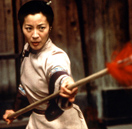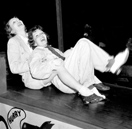
As the soccer ball sailed from the foot of veteran player Kristine Lilly to the head of up-and-comer Abby Wambach during the final match of the 2004 Olympics, the symbolism was obvious: This was not merely a pass, but a transition from one era to another. “Generation X” assisted “Generation Next” on the header goal that afternoon, winning the U.S. national team the gold medal.
It was to be the last time Mia Hamm, Julie Foudy, Joy Fawcett, Brandi Chastain and Kristine Lilly would play together in an Olympic competition due to the impending retirement of the three most prominent players—Hamm, Foudy and Fawcett. They received an indelible parting gift from their younger team members on that muggy August day. The Fab Five inspired millions of girls to take up soccer and were able to exit the world stage on top. “It was our way of saying thanks to them,” says Wambach, a striker who has emerged as the heir apparent to Hamm. “It was the only way it should have ended for them. Any other color but gold around their necks would not have been right.”

The team’s young players—hopefuls such as 24-year-old Wambach, 19-year-old forward Heather O’Reilly and 20-year-old midfielder Lindsay Tarplay—were key to the victory against Brazil, scoring the team’s final three goals. “We’ve had our day in the sun,” says Foudy, the retiring captain of the team, which finished with a 28-1-3 record in 2004. “It’s time for these young ladies to receive the credit they deserve. The bottom line is we couldn’t have done this without them. No way.”
In the wake of their Olympic success, the championship team returned home to launch a ten-city “Fan Celebration Tour,” which served as a final curtain call for the sport’s retiring stars. While it was the last time Hamm would don #9 on the field, the tour also offered audiences the opportunity to pay homage to a glorious past and glimpse into a future that could be every bit as golden.
 History was made along the way as Lilly became only the fifth woman to score 100 international goals and Wambach equaled the single-game mark for goals with five. The 32-year-old Hamm also gave fans something to remember her by, scoring four goals during the tour. The icon of women’s soccer now has a record 158 international goals.
History was made along the way as Lilly became only the fifth woman to score 100 international goals and Wambach equaled the single-game mark for goals with five. The 32-year-old Hamm also gave fans something to remember her by, scoring four goals during the tour. The icon of women’s soccer now has a record 158 international goals.
Throughout the tour, the team exhibited its trademark skill and enthusiasm, but these matches also had an emotional resonance for the audience and players alike. “Winning the Olympics was fantastic, but it’s been the highlight of my career to have these fan celebration games in front of the U.S. fans,” Foudy says. “I will miss competing and scrapping to win and just playing alongside such incredible people. It’s sad in a sense that I will miss these women, but it’s also a happy time because we are leaving the team in great hands and it’s time to move on.”
Hamm echoed those sentiments, adding, “It would have been a lot more difficult to say goodbye to the game if we didn’t have a talented, dedicated group of women to carry on.”
Of the new players who will attempt to build on the legacy established by Hamm and company, the most promising may be Wambach, who has become one of the most feared strikers in the world. “All I can say is that I’m glad Abby’s on my team because seeing her coming at me with the ball and a head of steam is a scary sight,” says veteran U.S. goalkeeper Briana Scurry of the 5-foot-11, 165-pound Wambach.
 Like her young teammates, Wambach grew up idolizing Hamm and the other veterans who dominated the sport for nearly two decades, winning two Olympic gold medals and two Women’s World Cup titles. “I had their posters on my wall, and every day when I woke up I’d look at them and remind myself that I wanted to be like them and have my own poster some day,” says Wambach, a native of Rochester, New York. “To be able to play with Mia and Julie and the others has been such an incredible experience. What an example they’ve set for us—I only hope we can do the same on and off the field.”
Like her young teammates, Wambach grew up idolizing Hamm and the other veterans who dominated the sport for nearly two decades, winning two Olympic gold medals and two Women’s World Cup titles. “I had their posters on my wall, and every day when I woke up I’d look at them and remind myself that I wanted to be like them and have my own poster some day,” says Wambach, a native of Rochester, New York. “To be able to play with Mia and Julie and the others has been such an incredible experience. What an example they’ve set for us—I only hope we can do the same on and off the field.”
Both the departing veterans and returning players are hopeful their success at the 2004 Olympics will be the catalyst for the formation of a new professional women’s soccer league. There is talk about reviving the Women’s United Soccer Association (WUSA), which folded after the 2003 season.
Foudy, Hamm and Fawcett are committed to lending their names and expertise to get the league relaunched, but they have no interest in suiting up again. “Been there, done that,” says Hamm. “It’s my turn to be a spectator and I’m going to have a lot of fun watching these new girls make their mark.” Undoubtedly, they will do just that.
:: Scott Pitoniak






